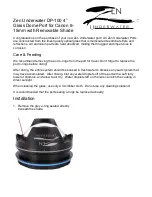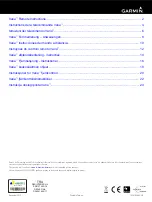
SDMS-30 Multipoint Scanning Snow Depth Sensor
8
6.2 RS-232/RS-422 Command List
Currently available serial commands in the command mode are listed with their
functions and usages in Table 6-2.
TABLE 6-2 RS-232/RS-422 Command List
Command
Usage
Default
Value
Function
@v
⏎
1
Set the verbose level: 0 - none/1 – show information.
The verbose level should be kept at 1 for use with the sample RS-232 datalogger program.
@i x
⏎
0 (polling
mode)
Set measurement interval in minutes. The sensor should be kept in polling mode for use with
the sample RS-232 datalogger program. The allowed values are 1, 2, 3, 4, 5, 6, 10, 20, 30 and
60.
@m
⏎
n/a
Start measurement..
The result immediately shows up if verbose level is set to 1. Otherwise, it will show up at
regular 1 minute interval.
@s
⏎
n/a
SDMS-30 status. This shows various system information such as current firmware version and
installation angle and height.
@a
⏎
n/a
Perform automatic calibration to determine installation angle and height
@h xx
⏎
Where xx
is the
height in
mm
n/a
Manually set the current sensor height in millimeters. This option would only be used if the
automatic calibration fails due to problems in the target area.
@g xx
⏎
Where xx
is the
existing
snow
depth
n/a
Reset the sensor ground level. This command would be used with the offset if there is existing
snow on the ground when the sensor is installed.
@lowtemp
x
⏎
Where x is
the desired
threshold
0°C
To check the current threshold value, type “@lowtemp”
⏎
.
To modify the heater threshold
value, includes the value x. The heater will turn on when the internal temperature drops below
this value, and will remain on until the temperature climbs above the threshold. The allowed
values are from -40°C to 10°C
@b x
⏎
Where x is
an index
for the
desired
baud rate
3
(9,600bps)
Check or modify the baud rate of the serial port. To check current the baud rate, type “@b”
⏎
. To modify the baud rate, include the desired index as per below.
0: 57600, 1: 38400, 2: 19200, 3: 9600, 4: 4800, 5: 2400, 6: 1200
@d
⏎
n/a
Check and modify the current SDMS-30 date
* to modify the SDMS-30 date, type “@d”
⏎
and follow instructions.
@t
⏎
n/a
Check and modify the current SDMS-30 time
* to modify the SDMS-30 time, type “@t”
⏎
and follow the instructions.











































